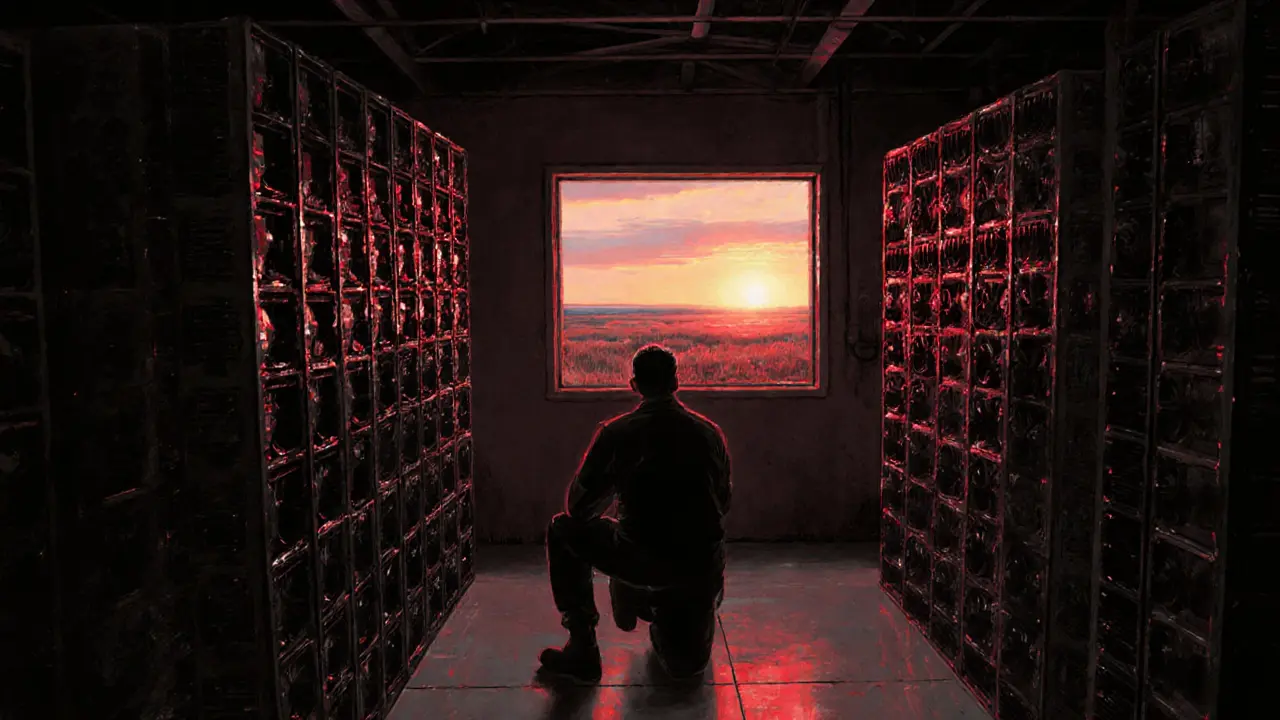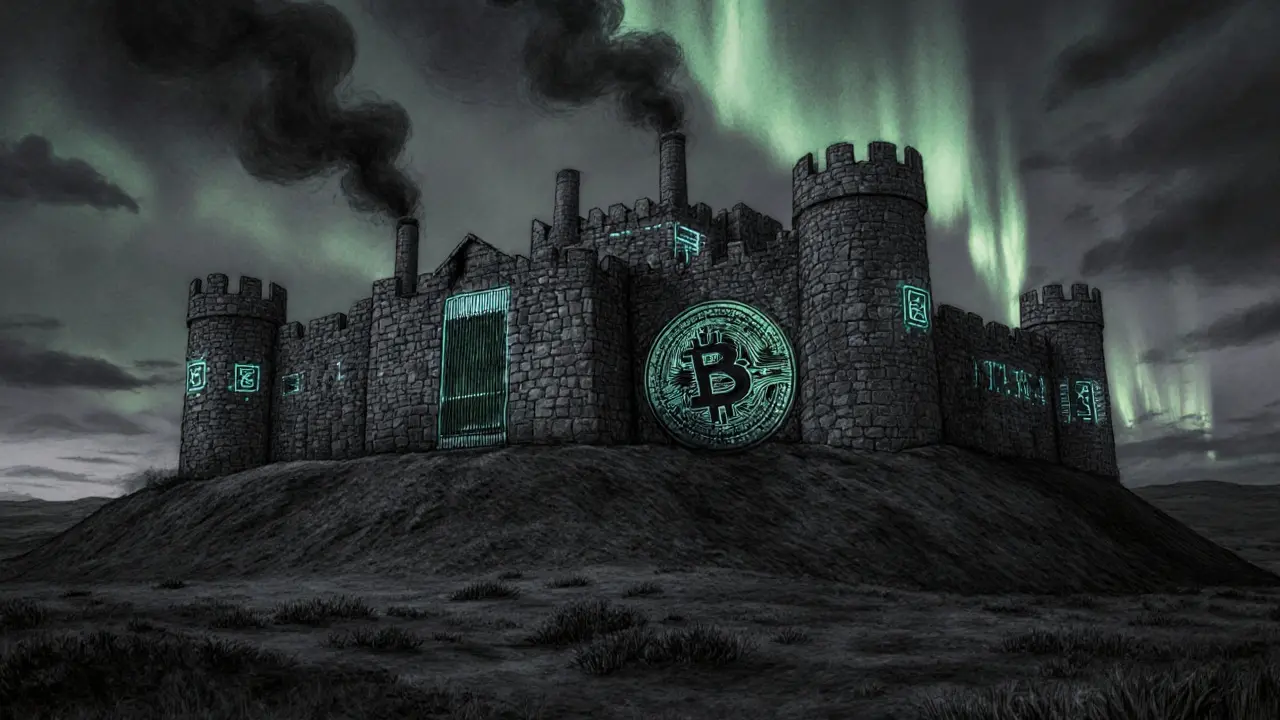Bitcoin Mining Profitability Calculator
Calculate Your Mining Profitability
Calculations
Based on 2025 mining data from the article: energy costs $0.085/kWh, Bitcoin price $70,000, and mining hardware efficiency at 32 W/TH/s.
Daily Energy Cost
$0.00
Cost to power your mining rig for 24 hours
Daily Revenue
$0.00
Estimated Bitcoin revenue from mining
Profitability
$0.00
Neutral
Break-even Time
Approximately 14.3 months (industry average)
According to the article: "The time to break even on a new ASIC rig? 14.3 months. In 2021, it was 8.2 months."
Proof of Work isn’t dead in 2025-but it’s no longer the default. If you’re wondering whether PoW still matters, the answer isn’t yes or no. It’s where it still matters. Bitcoin, the original blockchain, still runs on PoW. And as of mid-2025, it’s worth over $1.2 trillion. That’s not a fluke. It’s the result of 15+ years of uninterrupted security, no major hacks, no central authority, and a network that keeps running even when governments try to shut it down.
How Proof of Work Actually Works (No Jargon)
Think of PoW like a global competition. Miners use powerful computers to solve a math puzzle. The first one to solve it gets to add a new block of transactions to the blockchain-and gets rewarded in Bitcoin. Right now, that reward is 3.125 BTC per block, after the April 2024 halving. But the real magic isn’t the reward. It’s the cost.
Every time someone mines a block, they burn electricity. Lots of it. Bitcoin’s network uses about 121.72 terawatt-hours per year, more than 150 countries. That’s not a bug. It’s the feature. The energy isn’t wasted-it’s the price of security. To hack Bitcoin, you’d need to control more than half of all mining power. That means buying or building enough ASIC chips to outpace the entire planet’s mining rigs. And you’d need to power them all. The cost? Probably tens of billions. And even if you pulled it off, the market would crash. Your investment would be worthless. That’s the economic lock.
Why Everyone Moved Away from PoW
Ethereum switched to Proof of Stake in September 2022. That was the turning point. PoS doesn’t need miners. It uses validators who lock up (stake) ETH to participate. No energy-hungry rigs. No ASICs. No massive power bills. Validators earn about 3.15% APY. Over 29% of all ETH is staked. That’s real participation.
By June 2025, PoW networks made up only 18% of the total crypto market cap. PoS and hybrid models grabbed the rest. Why? Speed. Scalability. Cost.
Bitcoin processes 4-7 transactions per second. Visa does 24,000. Solana, a PoS chain, hits 65,000. For everyday payments, DeFi, or NFTs, PoW is too slow. Too expensive. Too wasteful. Enterprises noticed. Deloitte’s 2025 survey found only 4% of Fortune 500 blockchain projects use PoW. 67% use PoS. The rest use private, permissioned systems.
Where Proof of Work Still Wins
PoW’s only real advantage? It’s never been broken.
Bitcoin’s network has run for over 15 years without a single successful 51% attack. Not one. Ethereum’s PoS chain had a major validator outage in March 2024. Other PoS chains have been exploited through economic attacks-like bribing validators or exploiting staking rules. PoW doesn’t have those vulnerabilities. It doesn’t trust abstract financial incentives. It trusts physics. Electricity. Hardware. Heat. You can’t bribe a power plant.
Fidelity’s July 2025 analysis put it bluntly: “Manipulating Bitcoin’s PoW system would require controlling a majority of the computer chip supply chain plus sufficient electricity infrastructure-practical constraints making large-scale attacks nearly impossible.”
That’s why Bitcoin isn’t trying to be a payment network. It’s trying to be digital gold. A store of value. A hedge. And for that? PoW still works better than anything else.

The Decline of Mining: It’s Harder, Costlier, and Slower
If you thought mining Bitcoin in 2025 was like it was in 2017, you’re wrong.
Today, you need industrial gear. The Antminer S21, released in late 2024, is the current top miner. But it’s not something you plug into your garage. It needs 2.5 megawatts of power. That’s like running 500 homes. You need specialized cooling. Dedicated transformers. Insurance. Legal permits. Most solo miners are gone. The few left are in places with cheap power-Texas, Kazakhstan, Paraguay.
HashrateIndex’s Q2 2025 survey of 327 mining operations showed 63% had cut back due to rising energy costs. The average global electricity price for mining is now $0.085/kWh. The time to break even on a new ASIC rig? 14.3 months. In 2021, it was 8.2 months.
And the hardware? Bitmain’s Antminer S21 has a 3.2/5 rating on Trustpilot in 2025-down from 4.1 in 2021. People are frustrated. Returns are shrinking. The game changed.
Regulation Is Shaping the Future
In 2025, 28 countries have laws limiting PoW energy use. Canada, Germany, and Sweden have effectively banned large-scale mining. China’s ban in 2021 still echoes.
But in the U.S., things got clearer. On March 21, 2025, the SEC’s Division of Corporation Finance issued a statement: “Protocol Mining activities on public blockchains do not involve the offer and sale of securities.” That was huge. For the first time, miners had legal certainty. No more fear of being sued for just running a node.
That didn’t bring back the miners. But it stopped the panic. It gave Bitcoin’s PoW model a legal lifeline.

What’s Next for Proof of Work?
PoW isn’t disappearing. It’s becoming niche.
Gartner predicts PoW will make up only 10-15% of the blockchain market by 2030. Most of that will be Bitcoin. The rest? A few stubborn altcoins-Litecoin, Dogecoin, Kaspa. Maybe some new projects using PoW as a security layer for oracles or decentralized data verification.
One interesting path? Hybrid models. Decred, for example, uses PoW to create blocks and PoS to vote on protocol changes. It’s like having the security of Bitcoin with the governance of Ethereum. Could this be PoW’s evolution? Maybe.
Another? Bitcoin sidechains. The Drivechain protocol, expected in late 2025, could let users move assets off Bitcoin’s main chain to faster, cheaper networks-while keeping the main chain secure with PoW. That way, Bitcoin stays the vault. Other chains handle the transactions.
Who Still Uses PoW in 2025?
Two groups:
- Long-term Bitcoin holders-78% of them have held for over a year. They don’t care about speed. They care about permanence.
- Professional mining operators-the ones with data centers, power contracts, and cooling systems. They’re not hobbyists. They’re infrastructure providers.
Most crypto users? They’re on PoS chains. They’re staking ETH. Trading on Solana. Using Polygon. They don’t think about mining. They don’t need to.
Final Answer: Yes, But Only for This
Is Proof of Work still relevant in 2025? Yes. But only as the security backbone of Bitcoin. It’s not the future of blockchain. It’s the anchor. The bedrock. The last fortress of decentralized, trustless, energy-intensive security.
If you’re building a payment app? Use PoS. If you’re running a DeFi protocol? Use PoS. If you’re trying to store value for decades? PoW still has no real rival.
Bitcoin’s PoW network isn’t obsolete. It’s becoming a relic-but a valuable one. Like a vintage car that still runs better than any electric model in a crash. It’s not for everyone. But for those who need it? Nothing else works like it.
Is Bitcoin still using Proof of Work in 2025?
Yes. Bitcoin still runs entirely on Proof of Work. Despite Ethereum’s switch in 2022 and rising energy concerns, Bitcoin’s network has not changed its consensus mechanism. Its 15+ year security record is tied directly to PoW, and there’s no serious proposal to change it.
Why did Ethereum stop using Proof of Work?
Ethereum switched to Proof of Stake in September 2022 (The Merge) to reduce energy use by over 99.9%, improve scalability, and make participation easier for regular users. PoS eliminated the need for expensive mining hardware and cut electricity costs dramatically, allowing Ethereum to scale toward supporting millions of users and complex applications like DeFi and NFTs.
Can Proof of Work be hacked?
Technically yes-but it’s nearly impossible in practice. A 51% attack on Bitcoin would require controlling more than half of the global mining power, which means owning billions of dollars in ASIC chips and enough electricity to power a small country. Even if you succeeded, the value of Bitcoin would crash, making your attack worthless. No such attack has ever succeeded on Bitcoin.
Is mining Bitcoin profitable in 2025?
For individuals? Almost never. The cost of hardware, electricity, and cooling makes solo mining unprofitable for most. Only large-scale operations with access to cheap power (under $0.05/kWh) and industrial infrastructure can break even-and even then, it takes over a year to recover costs. Most miners now operate as part of mining pools or host services.
What’s replacing Proof of Work?
Proof of Stake (PoS) is the main replacement. Ethereum, Solana, Cardano, and most new blockchains now use PoS. It’s faster, cheaper, and more energy-efficient. Hybrid models-like Decred, which combines PoW and PoS-are also emerging as a middle ground for projects that want Bitcoin-level security without the environmental cost.
Will Proof of Work disappear by 2030?
Not entirely. Experts predict PoW will still power Bitcoin and a few niche chains, making up 10-15% of the blockchain market by 2030. But it won’t be the dominant model. Its role will shrink to secure, low-throughput applications-like digital gold-where security matters more than speed or efficiency.


thanks for this post, made me feel less dumb for not knowing the tech.